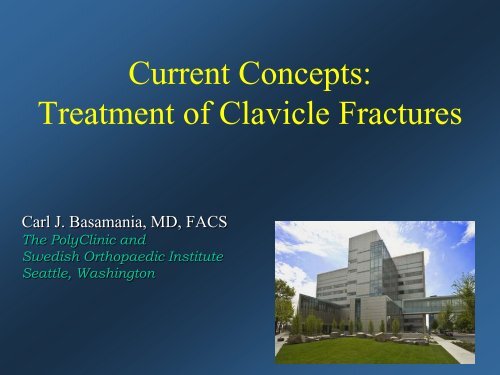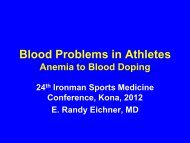Current Concepts: Treatment of Clavicle Fractures - CMX Travel
Current Concepts: Treatment of Clavicle Fractures - CMX Travel
Current Concepts: Treatment of Clavicle Fractures - CMX Travel
You also want an ePaper? Increase the reach of your titles
YUMPU automatically turns print PDFs into web optimized ePapers that Google loves.
<strong>Current</strong> <strong>Concepts</strong>:<br />
<strong>Treatment</strong> <strong>of</strong> <strong>Clavicle</strong> <strong>Fractures</strong><br />
Carl J. Basamania, MD, FACS<br />
The PolyClinic and<br />
Swedish Orthopaedic Institute<br />
Seattle, Washington
Disclosure:<br />
• Potential Conflict <strong>of</strong> Interest<br />
– DePuy/Johnson & Johnson<br />
• Consultant & royalties<br />
– Sonoma Orthopaedic Products<br />
• Consultant & stockholder<br />
• No honorariums, compensation paid by<br />
outside sources for this lecture<br />
• No “<strong>of</strong>f label” discussion <strong>of</strong> any products
Background<br />
• Nonoperative treatment has been<br />
the standard <strong>of</strong> care<br />
• Articles by Neer (1963) and Rowe<br />
(1968) both found a high incidence<br />
<strong>of</strong> complications with operative<br />
treatment<br />
• Both also reported a healing rate <strong>of</strong><br />
99% with non-operative treatment
Complications <strong>of</strong> non-operative treatment<br />
15% nonunion, 31% dissatisfaction regardless <strong>of</strong><br />
healing<br />
Hill, et al, JBJS(B), 1997
“All clavicles heal well”<br />
• One <strong>of</strong> the greatest fallacies in all <strong>of</strong><br />
orthopaedics<br />
• NO ONE has been able to reproduce<br />
the results <strong>of</strong> Neer and Rowe<br />
(nonunion
“All clavicles heal well” ?????<br />
• Meta-analysis <strong>of</strong> 2144 clavicle fractures:<br />
– Nonunion rate <strong>of</strong> 15.1%<br />
– Associated with displacement,<br />
comminution, female gender and age<br />
– Relative risk reduction <strong>of</strong> 86% for nonunion<br />
Zlowodski M, Zelle BA, Cole PA, Jeray K, McKee MD.<br />
<strong>Treatment</strong> <strong>of</strong> acute midshaft clavicle fractures: systematic<br />
review <strong>of</strong> 2144 fractures. J Orthop Trauma<br />
2005;19(7):504-508.
“All clavicles heal well” ?????<br />
• Union does not equate with good result<br />
• Long term follow-up <strong>of</strong> conservatively<br />
treated mid-shaft clavicle fx:<br />
– Average f/u: 54 months<br />
– Strength <strong>of</strong> injured side 66 – 86% <strong>of</strong><br />
uninjured side<br />
– Constant score 69<br />
– DASH score 25.1<br />
• McKee, M.D., et al, ASES, 2003
“All clavicles heal well”????<br />
• 46% <strong>of</strong> patients with clavicle<br />
fractures did not consider<br />
themselves fully recovered by 10<br />
years post-injury<br />
• 9% had pain at rest<br />
• 29% had pain with activity<br />
• Nowak, <strong>Clavicle</strong> <strong>Fractures</strong>, 2002
J. Bone Joint Surg. Am. 89:1-10, 2007<br />
Plate Fixation
Advantages <strong>of</strong> Plate Fixation<br />
• Easily available<br />
• Commonly used<br />
• Standard technique<br />
• Tension band<br />
• Direct osteon healing
• 3.5mm LCDC plate<br />
strongest<br />
• 3.5mm recon – easily<br />
contoured<br />
• 2.7mm DC plate<br />
weakest<br />
• Superior position<br />
strongest<br />
• However, fx pattern<br />
tested was transverse<br />
– Iannotti, Crosby,<br />
JSES,11,5,2002<br />
Plate Choice
Plate Position
Plate Position<br />
• Superior plate better if transverse fx<br />
• Anterior stronger if comminuted<br />
• Load to failure:<br />
– Non-comminuted:<br />
• Superior 301N<br />
• Anterior 217N<br />
– Comminuted:<br />
• Superior 198N<br />
• Anterior 265N<br />
– Harnroongroi, et al, Clin Biomech, 11,5,1996
Complications <strong>of</strong> Plate Fixation<br />
• Painful, prominent<br />
hardware<br />
• S<strong>of</strong>t tissue<br />
stripping<br />
• Non-cosmetic scar<br />
• Multiple stress<br />
risers<br />
– ? Permanent if ><br />
33% <strong>of</strong> clavicle<br />
diameter<br />
• Nerve damage
103 plated clavicle fractures –<br />
43% complication rate<br />
15% major complication rate<br />
14% reoperation rate<br />
Complications <strong>of</strong><br />
plate fixation<br />
Bostman, et al, J Trauma, 1997
Precontoured Plates<br />
• Precontoured plates are<br />
adequately shaped for<br />
the fixation <strong>of</strong> fractures<br />
in the medial threefifths<br />
<strong>of</strong> the clavicular<br />
shaft<br />
• Precountoured plates<br />
may not fit most white<br />
females<br />
• <strong>Clavicle</strong>s from female<br />
donors were narrower<br />
than the plates<br />
J Bone Joint Surg Am. 2007;89:2260-2265
Infection after Plate Fixation<br />
• Reports range from 0.4% - 7.8%<br />
• Bostman:<br />
• – 5 deep, 3 superficial<br />
– 7.8%<br />
• Liu, et al (2008):<br />
– 7 or 142<br />
– Average time to presentation: 28 days<br />
– 4.9%<br />
• Kaohsiung J Med Sci. 2008 Jan;24(1):45-9
Lateralization <strong>of</strong> cantilever effect in<br />
comminuted fractures – loss <strong>of</strong> tension<br />
band effect<br />
Would predict failure <strong>of</strong> lateral fixation
Failed Locking Plates
Failed Pre-Contoured Plates
Failed Plates
Ultimate Plate Failure
Intramedullary Fixation<br />
• IM fixation is not<br />
a new concept<br />
Intramedullary fixation with beef<br />
bone<br />
(Brockway, JBJS, 1930)
IM Fixation <strong>of</strong> <strong>Clavicle</strong> <strong>Fractures</strong><br />
• Gerhard Kuntscher 1900-1972<br />
• “Technik der Marknagelung”,<br />
1942<br />
• Described IM fixation <strong>of</strong><br />
clavicles<br />
• Died at his desk in December<br />
1972 while revising his book<br />
“Praxis der Marknagelung”
Why Intramedullary Fixation?<br />
• Minimizes s<strong>of</strong>t tissue dissection<br />
• Preservation <strong>of</strong> periosteal blood supply<br />
• Callus healing<br />
• Better resistance to repetitive bending<br />
• Ease <strong>of</strong> reduction<br />
– “If it’s IM – It’s anatomic!”<br />
• Allows clavicle to shorten<br />
• Minimal stress shielding<br />
• Ease <strong>of</strong> hardware removal<br />
• Cosmetic incisions
Problems with pin and IM fixation<br />
• Limited sizes<br />
• Migration<br />
• Static distraction<br />
(fully treaded pins)<br />
• Pin irritation
Elastic nailing<br />
Unfallchirurg 2006 · 109:200–211
Acta Orthopaedica 2007; 78<br />
(3): 424–429<br />
• Elastic nailing <strong>of</strong> 95<br />
midshaft clavicle fractures<br />
• Open fracture reduction<br />
required in 53 patients<br />
(56%)<br />
• Nonunion 2%<br />
• Malunion 8%<br />
• Pin migration 4%<br />
• Revision surgery 5%<br />
Elastic Nailing<br />
Average op time: closed 53 minutes<br />
open 63 minutes
Elastic Nail<br />
Acta Orthopaedica 2007; 78 (3): 421–423<br />
• 32 cases<br />
• 100% union<br />
• Open reduction necessary in 50%<br />
• Shortening > 5mm in 38%<br />
• Nail migration 25%<br />
– secondary shortening <strong>of</strong> the nail 16%<br />
• Nail breakage 6%
Supraclavicular nerve<br />
Supraclavicular nerve<br />
Medial fragment<br />
Platysma
Intramedullary Fixation
Intramedullary Technique
Lateral Placement
Securing Butterfly Fragments
Cutting the Pin
Acute Fracture Example
Postop Care<br />
• No immobilization utilized<br />
• Return to full ADL’s as soon as<br />
tolerated<br />
• Limit forward flexion ~ 3-4 weeks<br />
• Pin removed under local anesthesia 8 -<br />
12 weeks post-op
Acute Example
1 week postop
10 day followup
Plate versus Pin<br />
• Thyagarajan, 2005<br />
• 51 acute, midshaft fractures<br />
–17 pinned<br />
–17 plated<br />
–17 nonoperative treatment
Plate versus Pin<br />
• Pinning:<br />
– 100% union within 2-4 months<br />
– Shorter hospital stay<br />
• Plate:<br />
– 23.5% scar related pain<br />
– 17.5% prominent hardware & discomfort<br />
• Nonop<br />
– 23.5% nonunion<br />
– 29.4% cosmetic complaints<br />
– 6% malunion<br />
AAOS 2005
Plate versus Pin<br />
• 62 elderly patients with midshaft fxs<br />
• Mean shoulder score: pinning 85 points,<br />
plating 84 points (P=.7)<br />
• Pinning required significantly shorter<br />
operative time (P
Conclusion<br />
• Plate or intramedullary fixation can be<br />
considered for both<br />
• However, both have their limitations<br />
• Plate fixation is probably ideal with:<br />
–transverse, simple fractures<br />
–nonunions with bone loss<br />
• For all the rest, consider IM fixation



